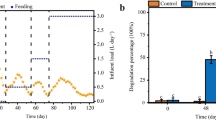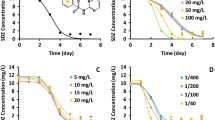Abstract
Recently we showed that during the degradation of sulfadiazine (SDZ) by Microbacterium lacus strain SDZm4 the principal metabolite 2-aminopyrimidine (2-AP) accumulated to the same molar amount in the culture as SDZ disappeared (Tappe et al. Appl Environ Microbiol 79:2572–2577, 2013). Although 2-AP is considered a recalcitrant agent, long-term lysimeter experiments with 14C-pyrimidine labeled SDZ ([14C]pyrSDZ) provided indications for substantial degradation of the pyrimidine moiety of the SDZ molecule. Therefore, we aimed to enrich 2-AP degrading bacteria and isolated a pure culture of a Terrabacter-like bacterium, denoted strain 2APm3. When provided with 14C-labeled SDZ, M. lacus strain SDZm4 degraded [14C]pyrSDZ to [14C]2-AP. Resting cells of 2APm3 at a concentration of 5 × 106 cells ml−1 degraded 62 µM [14C]2-AP to below the detection limit (0.6 µM) within 5 days. Disappearance of 2-AP resulted in the production of at least two transformation products (M1 and M2) with M2 being identified as 2-amino-4-hydroxypyrimidine. After 36 days, the transformation products disappeared and 83 % of the applied [14C]2-AP radioactivity was trapped as 14CO2. From this we conclude that a consortium of two species should be able to almost completely degrade SDZ in soils.






Similar content being viewed by others
References
Aislabie J, Davison D, Boul HL, Franzmann PD, Jardine DR, Karuso P (1999) Isolation of Terrabacter sp. Strain DDE-1, which metabolizes 1,1-dichloro-2,2-bis(4-chlorophenyl)ethylene when induced with biphenyl. Appl Environ Microbiol 65:5607–5611
Bouju H, Ricken B, Beffa T, Corvini PFX, Kolvenbach BA (2012) Isolation of bacterial strains capable of sulfamethoxazole mineralization from an acclimated membrane bioreactor. Appl Environ Microbiol 78:277–279
Brown EG, Turan Y (1996) Lathyrine biosynthesis and the origin of the precursor 2-amino-4-carboxypyrimidine in Lathyrus tingitanus. Phytochemistry 43:1029–1031
Collins MD, Dorsch M, Stackebrandt E (1989) Transfer of Pimelobacter tumescens to Terrabacter gen. nov. as Terrabacter tumescens comb. nov. and of Pimelobacter jensenii to Nocardioides as Nocardioides jensenii comb. nov. Int J Syst Bacteriol 39:1–6
Cornish-Bowden A (2013) Curbing the excesses of low demand. Nature 500:157–158
Habe H, Ide K, Yotsumoto M, Tsuji H, Yoshida T, Nojiri H, Omori T (2002) Degradation characteristics of a dibenzofuran-degrader Terrabacter sp. strain DBF63 toward chlorinated dioxins in soil. Chemosphere 48:201–207
Habe H, Chung JS, Ishida A, Kasuga K, Die K, Takemura T, Nojiri H, Yamane H, Omori T (2005) The fluorine catabolic linear plasmid in Terrabacter sp. strain DBF63 carries the ß-ketoadipate pathway genes, pcaRHGBDCFIJ, also found in proteobacteria. Microbiology 151:3713–3722
Hartig C, (2000) Analytik, Vorkommen und Verhalten aromatischer Sulfonamide in der aquatischen Umwelt. Doctoral Dissertation, Technical University of Berlin, http://webdoc.sub.gwdg.de/ebook/diss/2003/tu-berlin/diss/2000/hartig_claudia.pdf
Heldal M, Norland S, Tumyr O (1985) X-ray microanalytic method for measurement of dry matter and elemental content of individual bacteria. Appl Environ Microbiol 50:1251–1257
Hoffmann T, Hofmann D, Klumpp E, Küppers S (2011) Electrochemistry-mass spectrometry for mechanistic studies and simulations of oxidation processes in the environment. Anal Bioanal Chem 399:1859–1868
Iida T, Mukouzaka Y, Nakamura K, Kudo T (2002) Plasmid-borne genes code for an angular dioxygenase involved in dibenzofuran degradation by Terrabacter sp. strain YK3. Appl Environ Microbiol 68:3716–3723
Jenkins AH, Schyns G, Potot S, Sun G, Begley TP (2007) A new thiamin salvage pathway. Nat Chem Biol 3:492–497
Jurgenson CT, Begley TP, Ealick SE (2009) The structural and biochemical foundations of thiamin biosynthesis. Annu Rev Biochem 78:569–603
Kreuzig R, Höltge S (2005) Investigations on the fate of sulfadiazine in manured soil: laboratory experiments and test plot studies. Environ Toxicol Chem 24:771–776
Lagoja IM (2005) Pyrimidine as constituent of natural biologically active compounds. Chem Biodiv 2:1–50
Lee J-E, Seo JP, Lee DW, Ko Y-W, Lee SD (2008) Terrabacter lapilli sp. nov., an actinomycete isolated from stone. Int J Syst Evol Microbiol 58:1084–1088
Lindsey EA, Worthington RJ, Alcaraz C, Melander C (2012) 2-Aminopyrimidine as a novel scaffold for biofilm modulation. Org Biomol Chem 10:2552–2561
Minato Y, Fassio SR, Häse CC (2013) Malonate inhibits virulence gene expression in Vibrio cholerae. PLoS One 8:e63336
Mitchell WA (1987) Microbial degradation of guanidinium ion. Chemosphere 16:1071–1086
Montero-Barrientos M, Rivas R, Velázquez E, Monte E, Roig G (2005) Terrabacter terrae sp. nov., a novel actinomycete isolated from soil in Spain. Int J Syst Evol Microbiol 55:2491–2495
Pfeiffer T, Tuerk J, Fuchs R (2005) Structural characterization of sulfadiazine metabolites using H/D exchange combined with various MS/MS experiments. J Am Soc Mass Spectrom 16:1687–1694
Ricken B, Corvini PFX, Cichicka D, Parisi M, Lenz M, Wyss D, Martínez-Lavanchy PM, Müller JA, Shahgaldian P, Tulli LG, Kohler HP, Kolvenbach BA (2013) Ipso-hydroxylation and subsequent fragmentation: a novel microbial strategy to eliminate sulfonamide antibiotics. Appl Environ Microbiol 79:5550–5558
Ring DB, Johnson KW, Henriksen EJ, Nuss JM, Goff D, Kinnick TR, Ma ST, Reeder JW, Samuels I, Slabiak T, Wagman AS, Hammond ME, Harrison SD (2003) Selective glycogen synthase kinase 3 inhibitor potentiate insulin activation of glucose transport and utilization in vitro and in vivo. Diabetes 52:588–595
Sarian FD, van der Kaaij RM, Kralj S, Wijbenga DJ, Binnema DJ, van der Maarel MJEC, Dijkhuizen L (2012) Enzymatic degradation of granular potato starch by Microbacterium aurum strain B8.A. Appl Microbiol Biotechnol 93:645–654
Schmid A, Rothe B, Altenbuchner J, Ludwig W, Engesser KH (1997) Characterization of distinct extradio dioxygenase involved in mineralization of dibenzofuran by Terrabacter sp. strain DPO360. J Bacteriol 179:53–62
Schmidt B, Ebert J, Lamshöft M, Thiede B, Schumacher-Buffel R, Ji R, Corvini F-X, Schäffer A (2008) Fate in soil of 14C-sulfadiazine residues contained in manure of young pigs which were treated with the veterinary antibiotic. J Environ Sci Health Part B 43:8–20
Shachar-Hill Y (2013) Metabolic network flux analysis for engineering plant systems. Curr Opin Biotechnol. doi:10.1016/j.copbio.2013.01.004 (in press)
Sittig S, Kasteel R, Groeneweg J, Hofmann D, Thiele B, Köppchen S, Vereecken H (2014) Dynamics of transformation of the veterinary antibiotic sulfadiazine in two soils. Chemosphere 95:470–477
Stackebrandt E, Rainey FA, Ward-Rainey NL (1997) Proposal for a new hierarchic classification system, Actinobacteria classis nov. Int J Syst Bacteriol 47:479–491
Sukul P, Lamshöft M, Zühlke S, Spiteller M (2008) Photolysis of 14C-sulfadiazine in water and manure. Chemosphere 71:717–725
Tappe W, Herbst M, Hofmann D, Koeppchen S, Kummer S, Thiele B, Groeneweg J (2013) Degradation of sulfadiazine by Microbacterium lacus strain SDZm4, isolated from lysimeters previously manured with slurry from sulfadiazine-medicated pigs. Appl Environ Microbiol 79:2572–2577
Topp E, Chapman R, Devers-Lamrani M, Hartmann A, Marti R, Martin-Laurent F, Sabourin L, Scott A, Sumarah M (2013) Accelerated biodegradation of veterinary antibiotics in agricultural soil following long-term exposure, and isolation of a sulfamethazine-degrading Microbacterium sp. J Environ Qual 42:173–178
Zhou HW, Guo CL, Wong YS, Tam NFY (2006) Genetic diversity of dioxygenase genes in polycyclic aromatic hydrocarbon-degrading bacteria isolated from mangrove sediments. FEMS Microbiol Lett 262:148–157
Acknowledgments
This study was supported in part by the Deutsche Forschungsgemeinschaft FOR566, Veterinary Medicines in Soils: Basic research for Risk Analysis).
Author information
Authors and Affiliations
Corresponding author
Rights and permissions
About this article
Cite this article
Tappe, W., Hofmann, D., Disko, U. et al. A novel isolated Terrabacter-like bacterium can mineralize 2-aminopyrimidine, the principal metabolite of microbial sulfadiazine degradation. Biodegradation 26, 139–150 (2015). https://doi.org/10.1007/s10532-015-9722-9
Received:
Accepted:
Published:
Issue Date:
DOI: https://doi.org/10.1007/s10532-015-9722-9




